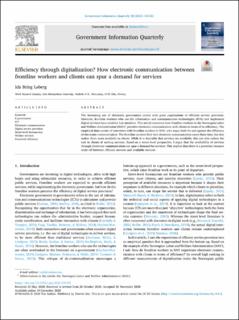| dc.contributor.author | Løberg, Ida Bring | |
| dc.date.accessioned | 2021-01-31T20:52:06Z | |
| dc.date.accessioned | 2021-03-09T11:03:45Z | |
| dc.date.available | 2021-01-31T20:52:06Z | |
| dc.date.available | 2021-03-09T11:03:45Z | |
| dc.date.issued | 2020-12-19 | |
| dc.identifier.citation | Løberg IB. Efficiency through digitalization? How electronic communication between frontline workers and clients can spur a demand for services. Government Information Quarterly: an international journal of information technology management, policies, and practices. 2020 | en |
| dc.identifier.issn | 0740-624X | |
| dc.identifier.issn | 1872-9517 | |
| dc.identifier.uri | https://hdl.handle.net/10642/9940 | |
| dc.description.abstract | The increasing use of electronic government comes with great expectations of efficient service provision. However, frontline workers who use the information and communication technologies (ICTs) and implement digital services have received less attention. This article examines how frontline workers in the Norwegian Labor and Welfare Administration (NAV)1 perceive electronic communication with clients in terms of its efficiency. The empirical data consist of interviews with frontline workers in NAV, who argue both for and against the efficiency of electronic communication. The frontline workers find that electronic communication saves them time, but also makes them more available to clients. While it is desirable that services are available, this can also reduce the cost to clients of seeking services. Based on a street-level perspective, I argue that the availability of services through electronic communication can spur a demand for services. This implies that there is a potential resource trade-off between efficient services and available services. | en |
| dc.description.sponsorship | This work was supported by the Centre for Work Inclusion at Oslo Metropolitan University; and The Research Council of Norway [grant number 256706 (INNOWEL project)]. | en |
| dc.language.iso | en | en |
| dc.publisher | Elsevier | en |
| dc.relation.ispartofseries | Government Information Quarterly; Volume 38, Issue 2, April 2021, 101551 | |
| dc.rights | Creative Commons Attribution 4.0 International (CC BY 4.0) license | en |
| dc.rights.uri | https://creativecommons.org/licenses/by/4.0/ | |
| dc.subject | E-governments | en |
| dc.subject | ICT | en |
| dc.subject | Electronic communication | en |
| dc.subject | Digital service provisions | en |
| dc.subject | Street level bureaucracies | en |
| dc.subject | Welfare services | en |
| dc.subject | Perceived efficiency | en |
| dc.subject | Information technologies | |
| dc.subject | Communications technologies | |
| dc.title | Efficiency through digitalization? How electronic communication between frontline workers and clients can spur a demand for services | en |
| dc.type | Journal article | en |
| dc.type | Peer reviewed | en |
| dc.date.updated | 2021-01-31T20:52:06Z | |
| dc.description.version | publishedVersion | en |
| dc.identifier.doi | https://doi.org/10.1016/j.giq.2020.101551 | |
| dc.identifier.cristin | 1882816 | |
| dc.source.journal | Government Information Quarterly: an international journal of information technology management, policies, and practices | |

